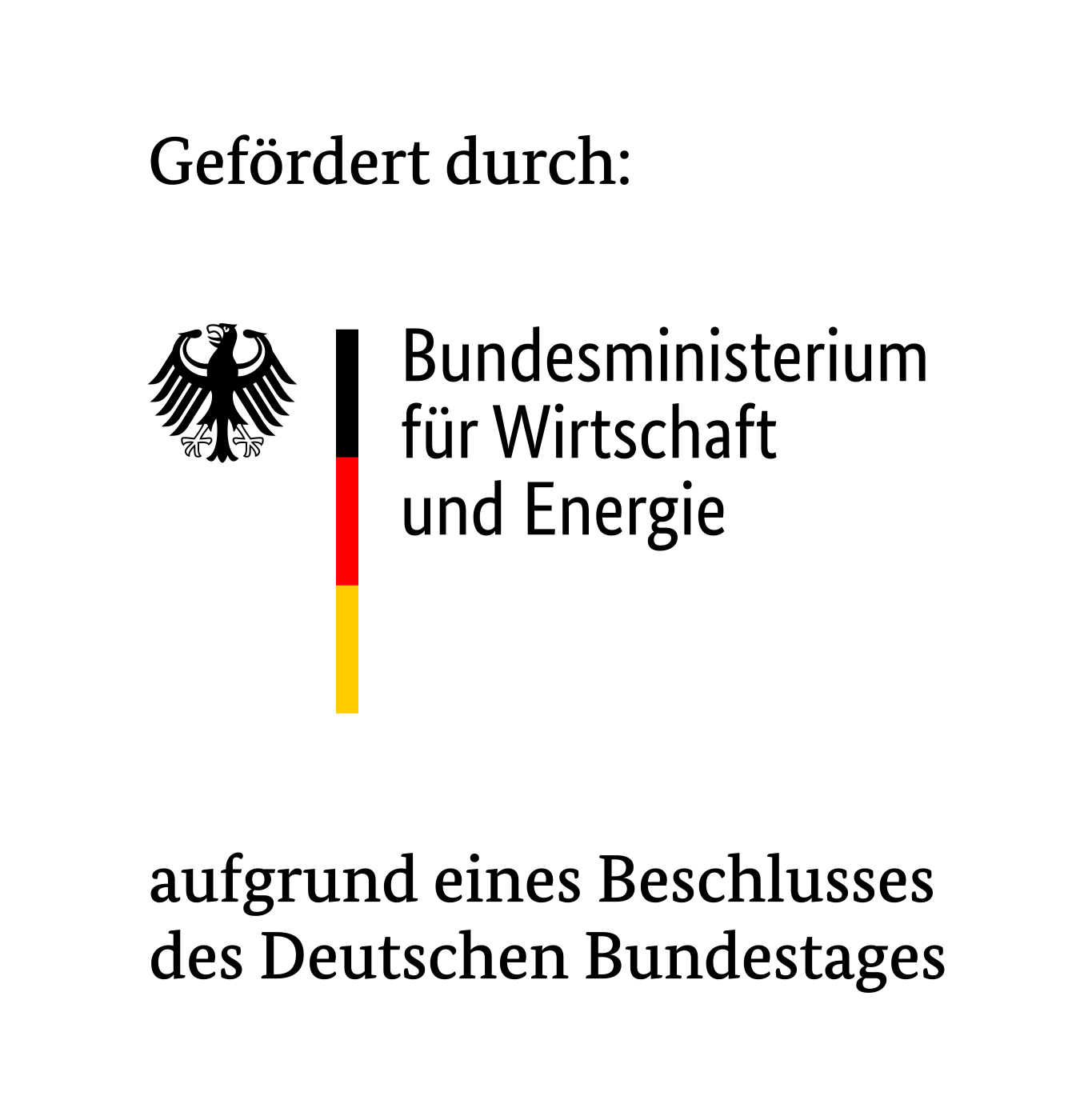
FKZ: 03ET6133A
Project Background
The envisaged transition towards renewable energies necessitates that the inherent fluctuations in their generation are compensated for in order to ensure a secure energy supply. In this endeavour, electrolyzers that utilize excess electric energy to generate hydrogen (H2) will play a crucial part. Moreover, the energy and mobility sectors will be adapted to be able to use hydrogen or natural gas as fuel.
The conversion of electric energy into its chemical counterpart allows of a long-term storage of energy. The generated hydrogen will be stored in proximity to the generation site or, alternatively, injected into the natural gas grid up to a volume fraction of 5 %.
To be able to feed this converted electric energy into the natural gas grid without any volumetric restriction, the hydrogen will be, subsequent to its generation, converted into methane, the main component of natural gas. This is achieved by the Sabatier-process during which carbon dioxide (CO2) or carbon monoxide (CO) are reacted with hydrogen at temperatures between 200 – 700 °C. This process, also called Power-to-Gas (PtG), offers further room for optimization in the exploitation of hydrogen’s potential to deliver energy.
![Figure 1: Scheme of the PtG-process with methanation following the electrolysis [1]](https://www.hsu-hh.de/ees/wp-content/uploads/sites/680/2020/06/Fig-1_EN_Methan.traditionell.png)
The state-of-the-art PtG-method utilizing the Sabatier-process suffers from the following drawbacks:
- Methanation is carried out in a separate apparatus and not directly after electrolysis
- No exploitation of temperature synergies leads to reduced efficiency
- High complexity in the machinery leads to high costs
An internal methanation in the gas exhaust pipe is a promising remedy for these drawbacks. An increase in efficiency is caused by using the heat of the electrolyzer directly for the methanation reaction. Also, a reduction in complexity of the machinery leads to lower costs.
Project Goal
During this project, the combination of electrolysis and methanation reactions within a single unit is investigated with the stated goal to enhance efficiency and reduce system costs (Figure 2). Focus is set on electrolysis via PEM-electrolyzers.
![Figure 2: Structure of the overall process of the electrolysis-methanation-cell [1]](https://www.hsu-hh.de/ees/wp-content/uploads/sites/680/2020/06/Fig-2_EN_Methan.NEU_.png)
Methodology
As the project commences, the software COMSOL Multiphysics® will be used to simulate physical models of different reactor designs for the internal methanation. Various geometries as well as material characteristics will be emulated and equations formulated that describe the reaction. The analysis of the simulation results will crystallize the most promising variants to be investigated experimentally. Then, prototypes will be manufactured and characterized using different catalysts. This will be done in a test stand that has been designed and developed in-house and installed in a laboratory of the work group. Finally, the catalysts will be examined as to their long-term stability.
Publications
Cosse, C.; Best, S.; Schulz, D.
Requirements for an Electrolysis-Methanation-Cell,
in: Hamburg‘s Contributions to Technical Climate Protection (German: „Anforderungen an die Elektrolyse-Methan-Zelle“, in: Hamburger Beiträge für den technischen Klimaschutz),
Helmut Schmidt University / University of the Federal Armed Forces Hamburg, Group for Electrical Power Systems, Hamburg, October 2019,
vol. 1, p. . 122-127, ISSN (print) 2698-8798, ISBN (print) 978-3-86818-247-7, ISSN (online) 2698-8801, ISBN (online) 978-3-86818-248-4
Best, S.; Cosse, C.; Schulz, D.
Hybrid-Plasma-Catalysis for Methanation in the Power-to-Gas Process,
in: Hamburg‘s Contributions to Technical Climate Protection (German: „Hybrid-Plasma-Katalyse zur Methanisierung im Power-to-Gas Prozess“, in: Hamburger Beiträge für den technischen Klimaschutz),,
Helmut Schmidt University / University of the Federal Armed Forces Hamburg, Group for Electrical Power Systems, Hamburg, October 2019,
vol. 1, p. 128-132, ISSN (print) 2698-8798, ISBN (print) 978-3-86818-247-7, ISSN (online) 2698-8801, ISBN (online) 978-3-86818-248-4
Cosse, C.; Best, S.; Schulz, D.
Applicability of Fixed Bed Reactors for Methanation in Electrolysis-Methanation-Cells,
REPE 2019 IEEE 2nd Int. Conf. on Ren. En. & Power Eng., Toronto, Canada, 2nd – 4th November, 2019
Project Partner:
The project StBZuEL – Development and Testing of electrically controllable Membrane Units in Polymer Electrolyte Fuel Cells and Electrolyzers with internal Methanation in the Gas Exhaust Pipe – is being pursued in cooperation with Altran Deutschland S.A.S & Co. KG.

Patente:
[1] Schulz, D.: Fuel Cell Membrane Unit, controllable Fuel Cell and High Pressure Electrolysis (German: „Brennstoffzellenmembraneinheit, steuerbare Brennstoffzelle und Hochdruckelektrolysezelle”), 15.12.2011, Patent DE 10 2011 088 613
[2] Schulz, D.: INTERNALLY CONTROLLABLE FUEL CELL, United States Patent, Patent No.: US 9,437,887 B2, Sep.6, 2016
[3] Schulz, D.: INTERNALLY CONTROLLABLE FUEL CELL, European patent No. 2791392, 16.08.2017
[4] Schulz, D.: INTERNALLY CONTROLLABLE FUEL CELL, Chinese patent, Patent No.: ZL2012800617937, 6.12.2017
[5] Schulz, D.: HIGH EFFICIENCY FUEL CELL, European patent No. 2978875, 07.03.18
[6] Schulz, D.: HIGH EFFICIENCY FUEL CELL, Chinese patent, Patent No.: ZL 2014800178483, 22.06.2018
[7] Schulz, D.: HIGH EFFICIENCY FUEL CELL, United States Patent, Patent No.: US 1050235506 B2, Jul. 17, 2018
[8] Schulz, D.: HIGH EFFICIENCY FUEL CELL, Japanese Patent Number 6462660, 11.01.2019
[9] Schulz, D.: INTERNALLY CONTROLLABLE FUEL CELL, Japanese Patent Number 8486105, 01.03.2019
[10] Schulz, D.: INTERNALLY CONTROLLABLE FUEL CELL, Korean Patent Number 10-2001703, 12.07.2019
Contact:
Prof. Dr.-Ing. habil. Detlef Schulz (project lead)
Dipl.-Phys. Stefan Best
Dr. rer. nat. Daniel Becker
Faculty for Electrical Engineering
Electrical Power Systems
Letzte Änderung: 28. May 2021
